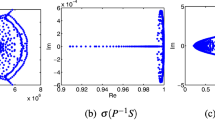Abstract
Preconditioners are popularly used for speeding up Krylov subspace iterative method for solving linear systems from discretization of fractional differential equations (FDEs) on rectangular domains. Though some recent works have been developed for FDEs in general convex domains, it still has room for improvement in the design of preconditioner. For this sake, in this paper, we theoretically study the preconditioner problem for two-dimensional conservative space-fractional diffusion equations with variable coefficients and propose a robust preconditioner with penalty term which can deal with any convex domains significantly. We further prove that the proposed preconditioner equals to the coefficient matrix plus a low rank matrix and a matrix with small norm under certain conditions. It implies that the new preconditioner can effectively accelerate the convergence rate of Krylov subspace method. Experimental results show the good performance of the robust preconditioner.



Similar content being viewed by others
References
Bai, J., Feng, X.: Fractional-order anisotropic diffusion for image denoising. IEEE Trans. Image Process. 16, 2492–2502 (2007)
Benson, D., Wheatcraft, S.W., Meerschaert, M.M.: Application of a fractional advection-dispersion equation. Water Resour. Res. 36(6), 1403–1413 (2000)
Benson, D., Wheatcraft, S.W., Meerschaert, M.M.: The fractional-order governing equation of Lévy Motion. Water Resour. Res. 36(6), 1413–1423 (2000)
Chan, R.H., Strang, G.: Toeplitz equations by conjugate gradients with circulant preconditioner. SIAM J. Sci. Stat. Comput. 10(1), 104–119 (2006)
Chen, S., Liu, F., Turner, I., Anh, V.: A fast numerical method for two-dimensional Riesz space fractional diffusion equations on a convex bounded region. Appl. Numer. Math. 134, 66–80 (2018)
Ervin, V.J., Heuer, N., Roop, J.P.: Numerical approximation of a time dependent, nonlinear, space-fractional diffusion equation. SIAM J. Numer. Anal. 45(2), 572–591 (2007)
Fan, W., Jiang, X., Liu, F., Anh, V.: The unstructured mesh finite element method for the two-dimensional multi-term time-space fractional diffusion-wave equation on an irregular convex domain. J. Sci. Comput. 77, 27–52 (2018)
Fan, W., Liu, F.: A numerical method for solving the two-dimensional distributed order space-fractional diffusion equation on an irregular convex domain. Appl. Math. Lett. 77, 114–121 (2018)
Huang, Q., Huang, G., Zhan, H.: A finite element solution for the fractional advection-dispersion equation. Adv. Water Resour. 31, 1578–1589 (2008)
Jia, J., Wang, H.: A fast finite volume method for conservative space-fractional diffusion equations in convex domains. J. Comput. Phys. 310, 63–84 (2016)
Jia, J., Wang, H.: A fast finite difference method for distributed-order space-fractional partial differential equations on convex domains. Comput. Math. Appl. 75, 2013–2043 (2018)
Jin, X.: Preconditioning Techniques for Toeplitz Systems. Higher Education Press, Beijing (2010)
Jin, X., Lin, F., Zhao, Z.: Preconditioned iterative methods for two-dimensional space-fractional diffusion equations. Commun. Comput. Phys. 18(2), 469–488 (2015)
Lei, S., Chen, X., Zhang, X.: Multilevel circulant preconditioner for high-dimensional fractional diffusion equations. East Asian J. Appl. Math 6, 109–130 (2016)
Lei, S., Sun, H.: A circulant preconditioner for fractional diffusion equations. J. Comput. Phys. 242(5), 715–725 (2013)
Li, X., Xu, C.: Existence and uniqueness of the weak solution of the space-time fractional diffusion equation and a spectral method approximation. Commun. Comput. Phys. 8(5), 1016–1051 (2010)
Lin, F., Yang, S., Jin, X.: Preconditioned iterative methods for fractional diffusion equation. J. Comput. Phys. 256, 109–117 (2014)
Lin, X., Ng, M., Sun, H.: A multigrid method for linear systems arising from time-dependent tow-dimensional space-fractional diffusion equations. J. Comput. Phys. 336, 69–86 (2017)
Liu, F., Zhuang, P., Turner, I., Anh, V., Burrage, K.: A semi-alternating direction method for a 2-D fractional FitzHugh?Nagumo monodomain model on an approximate irregular domain. J. Comput. Phys. 293, 252–263 (2015)
Liu, F., Zhuang, P., Turner, I., Burrage, K., Anh, V.: A new fractional finite volume method for solving the fractional diffusion equation. Appl. Math. Model. 38, 3871–3878 (2014)
Lyu, P., Vong, S.: A linearized second-order scheme for nonlinear time fractional Klein-Gordon type equations. Numer. Algorithms (2017)
Magin, R.L.: Fractional Calculus in Bioengineering. Begell House Publishers Inc., Chicago (2006)
Meerschaert, M.M., Scheffler, H.P., Tadjeran, C.: Finite difference methods for two-dimensional fractional dispersion equation. J. Comput. Phys. 211, 249–261 (2006)
Moroney, T., Yang, Q.: Efficient solution of two-sided nonlinear space-fractional diffusion equations using fast Poisson preconditioners. J. Comput. Phys. 246, 304–317 (2013)
Pan, J., Ke, R., Ng, M.K., Sun, H.: Preconditioning techniques for digonal-times-Toeplitz matrices in fractional diffusion equations. SIAM J. Sci. Comput. 36(6), A2698–A2719 (2014)
Pan, J., Ng, M., Wang, H.: Fast preconditioned iterative methods for finite volume discretization of steady-state space-fractional diffusion equations. Numer. Algor. 74, 153–173 (2017)
Podlubny, I.: Fractional Differential Equations. Academic Press, New York (1999)
Raberto, M., Scalas, E., Mainardi, F.: Waiting-times and returns in high-frequency financial data: an empirical study. Physica A. 314, 749–755 (2002)
Ritchie, K., Shan, X., Kondo, J., Iwasawa, K., Fujiwara, T., Kusumi, A.: Detection of non-Brownian diffusion in the cell membrane in single molecule tracking. Biophys. J. 88, 2266–2277 (2005)
Roop, J.P.: Computational aspects of FEM approximation of fractional advection dispersion equations on bounded domains in \(R^2\). J. Comput. Appl. Math. 193, 243–268 (2006)
Sabzikar, F., Meerschaert, M.M., Chen, J.: Tempered fractional calculus. J. Comput. Phys. 293, 14–28 (2015)
Samko, S., Kilbas, A., Marichev, O.: Fractional Integrals and Derivatives: Theory and Applications. Gordon and Breach Science Publishers, Philadelphia (1993)
Scher, H., Montroll, E.W.: Anomalous transit-time dispersion in amorphous solids. Phys. Rev. B. 12, 2455–2477 (1975)
Sokolov, I.M., Klafter, J., Blumen, A.: Fractional kinetics. Phys. Today 55(11), 48–53 (2002)
Song, F., Xu, C.: Spectral direction splitting methods for two-dimensional space fractional diffusion equations. J. Comput. Phys. 299, 196–214 (2015)
Vong, S., Wang, Z.: A high order compact finite difference scheme for time fractional Fokker-Planck equations. Appl. Math. Lett. 43, 38–43 (2015)
Wang, H., Zhang, X.: A high-accuracy preserving spectral Galerkin method for the dirichlet boundary-value problem of variable-coefficient conservative fractional diffusion equations. J. Comput. Phys. 281, 67–81 (2015)
Yang, Z., Yuan, Z., Nie, Y., Wang, J., Liu, F.: Finite element method for nonlinear Riesz space fractional diffusion equation on irregular domains. J. Comput. Phys. 330, 863–883 (2017)
Zhang, X., Crawford, J.W., Deeks, L.K., Shutler, M.I., Bengough, A.G., Young, I.M.: A mass balance based numerical method for the fractional advection-dispersion equation: Theory and application. Water Resour. Res. 41, 1–10 (2005)
Acknowledgements
The authors would like to thank Mr. Yun-Chi Huang from University of Macau for his helpful discussion, and also the referees for their valuable comments and suggestions that improved the quality of this article.
Author information
Authors and Affiliations
Corresponding author
Additional information
Publisher's Note
Springer Nature remains neutral with regard to jurisdictional claims in published maps and institutional affiliations.
This work is supported by the University of Macau [MYRG2016-00202-FST, MYRG2018-00025-FST] and the Science and Technology Development Fund, Macao S.A.R. (FDCT) [048/2017/A].
Appendix
Appendix
1.1 A. Proof of Lemma 1
Proof
Define \(f_a(x)=-\frac{1}{2}(x+\frac{1}{2})^\alpha +\frac{1}{\alpha +1}[(x+1)^{\alpha +1}-(x+\frac{1}{2})^{\alpha +1}]\), then we have \(a_m^{(\alpha )}=f_a(m)-f_a(m-1)\). Observed that
with \(t=\frac{x+\frac{1}{2}}{x+1}\), which satisfies \(0<t<1\) provided \(x\ge 1\).
Denote \(q_{a}(t)=t^{1-\alpha }-[(1-\alpha )t+\alpha ]\), then \(q'_{a}(t)=(1-\alpha )(t^{-\alpha }-1)>0,\) so that \(q_{a}(t)\) is a monotonic increasing function and the root locates at \(t=1\), which implies that \(q_a(t)<0\) when \(0<t<1\). It is clear that \(\frac{(2-2t)^{-\alpha }}{t^{1-\alpha }}>0\), hence \(f'_a(x)<0\), \(t\in (0,1)\), which yields \(\{a^{(\alpha )}_m\}\) is negative for \(m\ge 1\). Similarly,
Let \(p_a(t)=t^{2-\alpha }-[(2-\alpha )t+(\alpha -1)]\). Due to \(p'_{a}(t)=(2-\alpha )(t^{1-\alpha }-1)<0\) and \(p_{a}(1)=0\), we obtain \(p_a(t)>0\) when \(0<t<1\). Hence \(f''_a(x)>0\) for \(t\in (0,1)\), which implies \(\{a^{(\alpha )}_m\}\) is an increasing sequence for \(m\ge 1\).
In the same way, \(\{b_m^{(\alpha )}\}\) can be written as \(b_m^{(\alpha )} = f_b(m)-f_b(m-1)\), where
Let \(t=\frac{x}{x+\frac{1}{2}}\), then
Note that \(t^\alpha -\alpha t-1+\alpha < 0\) and \(t^{\alpha -1}-(\alpha -1)t-2+\alpha >0\) when \(0<t<1\). One can similarly prove that \(f'_b(x)>0\) and \(f''_b(x)<0\). Therefore, \(\{b_m^{(\alpha )}\}\) is a positive and decreasing sequence.
As for the sequence \(\{c_m^{(\alpha )}\}\), we firstly define \(f_c(x)=\frac{1}{2}[(x+\frac{3}{2})^\alpha -(x+\frac{1}{2})^\alpha ]\) and \(g_c(x)=\frac{1}{1+\alpha }[(x+\frac{3}{2})^{\alpha +1}+(x+\frac{1}{2})^{\alpha +1}-2(x+1)^{\alpha +1}],\) then
Define \(k_c(x)=x^{\alpha }\), then we know that \(k''_c(x)=\alpha (\alpha -1)x^{\alpha -2}<0\) and \(k_c(x)\) is concave. Hence, \(g_c'(m)=k_c(m+\frac{3}{2})+k_c(m+\frac{1}{2})-2k_c(m+1)<0\). Besides, it is clear that \(f'_c(m)<0\), thus \(c^{(\alpha )}_{m} < 0\). Let \(q_c(x)=x^{\alpha -1}\), then
which implies that \(q_c(x)\) is a convex function, i.e.,
Therefore,
and
which yields that
Consequently \(\{c_m^{(\alpha )}\}\) is an increasing sequence for \(m\ge 1\).
1.2 B. Proof of Lemma 3
Proof
In accordance with the proof of the Lemma 1,
Then
and
As \(m\ge 1\) and \(0<\alpha <1\), it holds that
With the similar proof, when \(m>1\), it is satisfied that
It is easy to know that \(b_1^{(\alpha )}\le 2^{1-\alpha }\alpha \). In sum, we have
for all \(m\ge 1\) and \(0<\alpha <1\).
The proof for sequence \(\{a_m^{(\alpha )}\}\) is similar to the one of \(\{b_m^{(\alpha )}\}\).
1.3 C. Proof of Lemma 6
Proof
First of all, we consider the matrix \(A^{x}_{0}\). For any given \(\epsilon >0\), take
from Lemma 1 and Lemma 3, for all \(n>N_0\), we have
and
For the matrix \(A^x_1\), take
For all \(n>N_1\), we get
and
For the matrix \(A^x_{-1}\), with similar way, take
for all \(n>N_{-1}\), we obtain \(\sum ^{\infty }_{m=n+1}|w^{(\alpha )}_{-1,m}|<\epsilon \) and \(\sum ^{\infty }_{m=n+1}|w^{(\alpha )}_{-1,-m}|\le \epsilon \).
In sum, the result of the theorem follows by taking \(N_c= \max \{N_{-1},N_0,N_1\}\).
1.4 D. Proof of Lemma 7
Proof
Without loss of generality, we focus on the case when the matrix size \(N_x\) is even. With the definition of Strang’s circulant approximation, we have
where \(j=-1\), 0, 1, and
Obviously, the rank of matrix \(E_j^x\) is \(2N_c\). On the other hand, since \(U_j^x\) is a Toeplitz matrix, with Lemma 6, we have
In a similar way, we know that \(\Vert U_j^x\Vert _\infty \le 2\epsilon \), therefore,
When \(N_x\) is odd, the theorem can be proven similarly.
1.5 E. Proof of Lemma 8
Proof
With the assumption that P is invertible, it holds that
Since
it implies that
Rights and permissions
About this article
Cite this article
Chen, X., Deng, SW. & Lei, SL. A Robust Preconditioner for Two-dimensional Conservative Space-Fractional Diffusion Equations on Convex Domains. J Sci Comput 80, 1033–1057 (2019). https://doi.org/10.1007/s10915-019-00966-7
Received:
Revised:
Accepted:
Published:
Issue Date:
DOI: https://doi.org/10.1007/s10915-019-00966-7
Keywords
- Space-fractional diffusion equation
- Block-circulant-circulant-block matrix
- Preconditioner
- Finite volume method
- Convex domain




